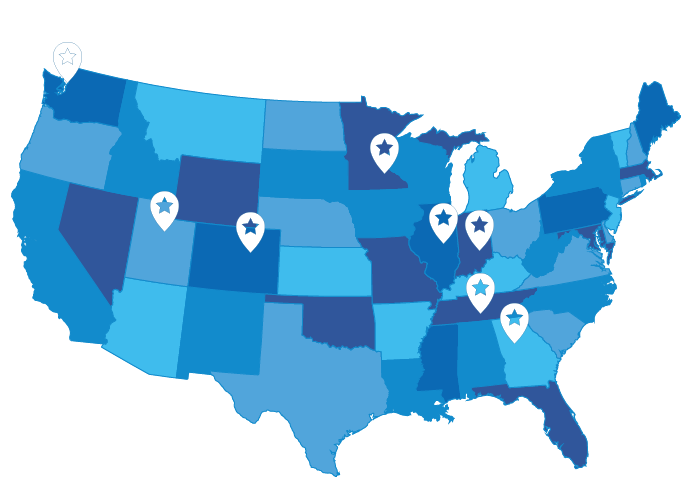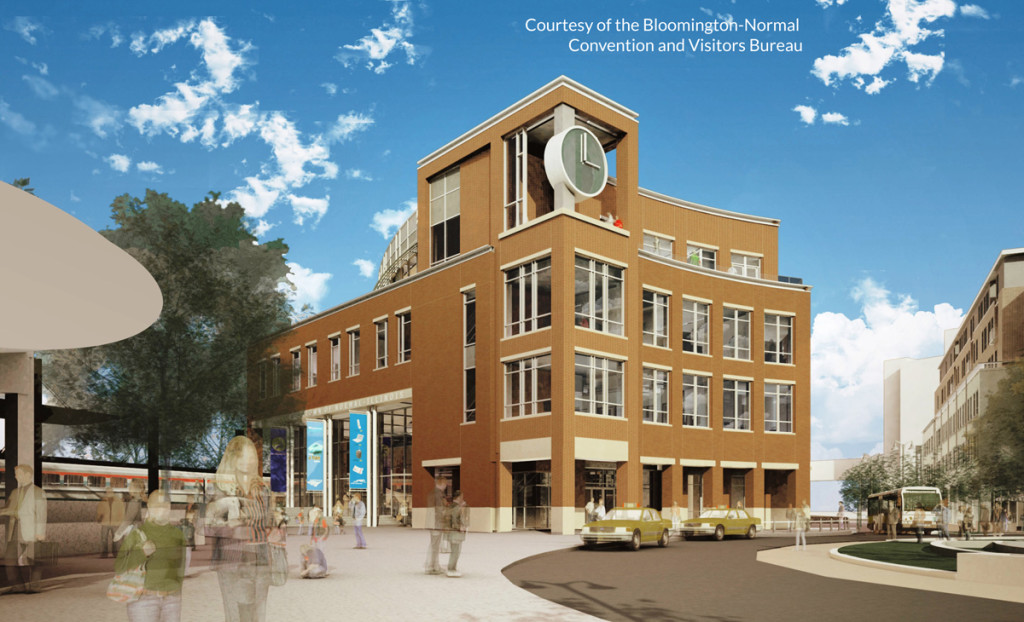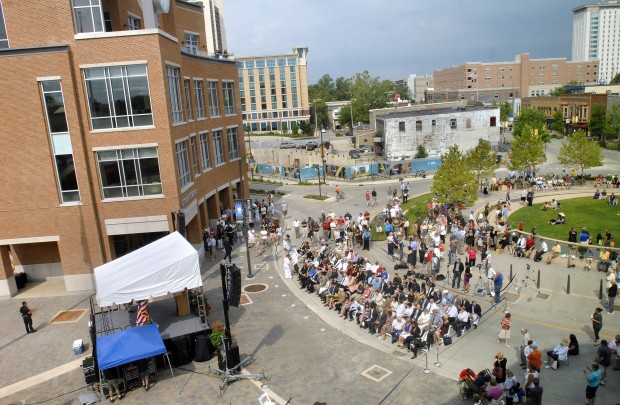Normal Leads the TIGER Pack
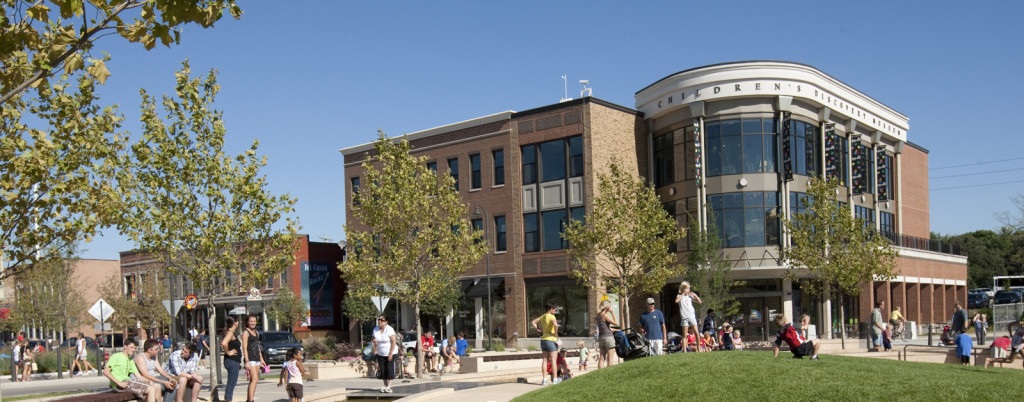
The new Children’s Museum and roundabout in the center of Uptown Normal, Illinois. Photo courtesy of Scott Shigley
Don’t miss the short video we produced on Normal’s story at the bottom of this post. -Ed.
Back in the 2009 federal economic stimulus package, Congress created an experimental program of competitive grants that became known as TIGER, for Transportation Investment Generating Economic Recovery — intended to fund complex, innovative projects that did not fit into existing narrow federal funding silos.
In 2010, Normal Illinois’ Uptown multimodal station was one of the first 51 (of thousands of applicants) to win a grant, but the very first to break ground. “We were truly shovel-ready,” said Wayne Aldrich, director of development for Normal’s Uptown redevelopment. Getting to that point, however, took more than a decade.
As in many towns across America, Normal’s development in recent years had occurred primarily out on its perimeter, and for the last decade of the 20th century its central business district struggled. While most buildings were occupied, rents were low, turnover was high, and the area was beginning to lose key businesses. The city’s leaders and the business community began to rally around a vision to help boost Normal’s core and awaken it into a key asset that could help them compete and prosper economically.
A new plan for Uptown
In 1999, Normal hired Chicago urban designer Doug Farr to create a revitalization plan for the downtown, known locally as Uptown.
Farr’s plan re-imagined Uptown Normal as a central city plaza anchored by a relocated Amtrak station that would become the hub of several modes and activities. He suggested rewriting design codes so that surrounding buildings would support a walkable center, with active uses like shops or restaurants on the ground floor. And he asked town leaders to stretch even farther, to require that buildings meet green design standards under Leadership in Energy and Environmental Design (LEED), and to use tax increment financing (TIF) to build public amenities like a central plaza to serve as a focal point and gathering place.
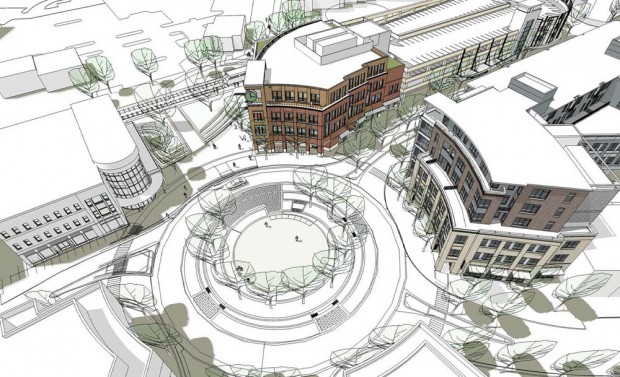
A rendering of the Normal Multimodal Transportation Center and new roundabout. (Photo courtesy of Uptown Normal)
Following through on the plan required taking a risk. It required the city to shift gears from a fiscally conservative, pay-as-you go mindset to an investment strategy built on debt financing.
Believing in the investment and seeing it through
“We figured that if we were going to go back into debt, it would have to be for something special,” said Mayor Chris Koos. The city established a quarter-percent sales tax, a four-percent hotel tax, and a TIF district, within which the town would invest a share of rising property tax receipts in streetscapes that paid attention to the needs of pedestrians. The town also used new revenue to build a LEED certified museum, and passed a municipal ordinance requiring new buildings to be LEED-certified.
“Had we known how much resistance we would meet, I’m not sure we would have gone through with it,” said City Manager Mark Peterson.
Some community members questioned if the plan would be a wise use of taxpayer dollars, and at least two city council members lost their seats in the process, he said. The town regularly had to go on the defensive to justify new economic development concepts to community members and state agencies alike.
“We were using terms like ‘transit-oriented development’, ‘pedestrianism’, and ‘sustainability’ even before they were national buzzwords,” said Peterson. Even the state’s economic development agency remained skeptical of a strategy that at the time was cutting edge, he said. Town officials found they had to educate groups to bring them on board with their vision. All along, the city remained focused on the linchpin transportation center because it was central to their revitalization concept.
Officials held more than 100 public meetings to secure the support of sister city Bloomington, nearby universities, school districts, business, and labor.
“Beyond the need to educate people about our vision, it was important to have everyone on board so that politicians could feel safe about getting behind the project,” said Peterson. Normal hired a lobbyist and for five years city leaders knocked on congressional doors, eventually winning earmarks of $10 million with help from Senator Dick Durbin – but not enough to build the station. Years of outreach and door knocking took its toll on a lean and overworked staff at the city. “There were times where we were sick of even hearing the word multimodal,” Peterson recalled.
Then, after the recession hit, a stimulus
The 2009 stimulus initially looked like a bust for Normal.
“The state put that first round of stimulus money into hot-mix asphalt,” said Peterson. “That’s spending that doesn’t create jobs, isn’t sustainable, benefits maybe 300 contractors, and will last maybe ten years.” So when the town applied for the first round of TIGER grants in 2009, also funded by the stimulus package, many remained skeptical that their community could compete successfully in a national program.
Their work, however, paid off. The U.S. Department of Transportation (DOT) selected Normal’s project as one of 51 out more than 1,500 applications. All told, the $49.5 million project received $22 million from TIGER, $10.6 million in additional federal funding and more than $13 million in state and local contributions.
A new station opens and the strategy begins to pay off
Since opening in July 2012, Uptown Station and its innovative circular plaza have become the new heart of the town. City Hall relocated to the upper floors of the station building, a children’s museum began drawing families and school visits from miles around, a major hotel and other businesses opened.
And most importantly, Normal’s long-term economic development strategy is already paying off. Since 2004, Normal’s central area has lured $220 million in private investment, and there are additional plans in the works for additional mixed-use office buildings and condos.
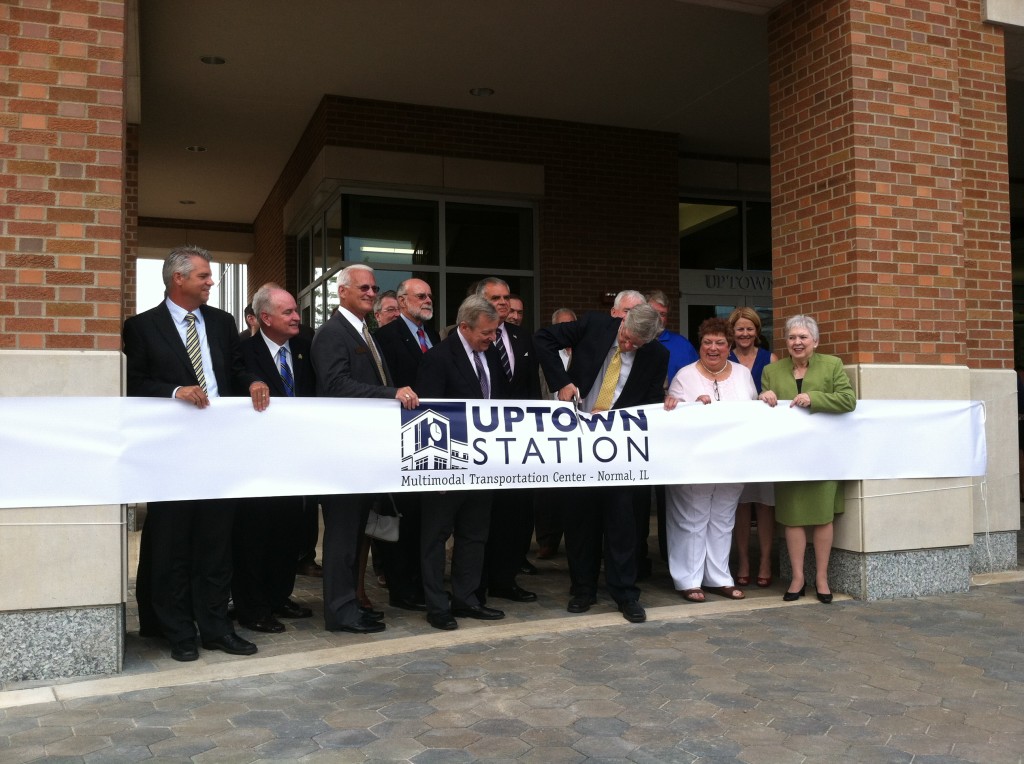
Mayor Koos cuts the ribbon on Uptown Station while accompanied by Transportation Secretary Ray LaHood (next to Mayor Koos’ elbow) and Senator Dick Durbin (watching, next on left). Sen Durbin was instrumental in supporting the project as well as repeatedly fighting to preserve funding for the TIGER grant program so that other communities might replicate the success of Normal.
The federal investment in this station leverages ongoing investments in passenger rail as Amtrak ridership grows. The station opened in advance of new, faster 110 mph service that started back in 2012, making the trip from Chicago to Normal in about two hours and from Normal to St. Louis in less than two and a half hours.
The local bus service has since relocated its hub to Uptown Station. Despite challenges with timely service due to the region’s spread out subdivisions, ridership is up year over year. Inter-city bus service leaves from the station to Peoria, the Chicago airport, Denver and other destinations. The town plans to expand its multimodal infrastructure and is implementing a regional bicycle transportation plan, though funding it will take time.
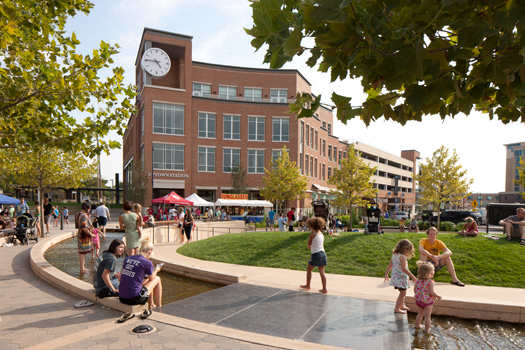
The Town of Normal’s unprecedented dedication to reinventing its downtown, and the success that followed, gives new meaning to its motto, “Anything but.” Photo courtesy of Scott Shigley.
Investments that will reap rewards for decades to come
“We can’t afford not to think about this,” said Normal Mayor Chris Koos, who knows a bit about the bottom line as the owner of a small business in Uptown since 1979. “We have to get more bang for our buck, and single-occupancy vehicles is not that. We have to find ways to carry more people on our transportation corridors.”
But it’s also about providing for residents, he added. “How many families are choosing to go down to one car? For a two-car family with a 30-year mortgage, getting rid of one car is the equivalent of adding a quarter million dollars of buying power over the life of the mortgage,” Mayor Koos said.
Normal has since seen representatives from many other communities come calling to learn the town’s key to success.
“There are a lot of places that want this. The only reason you don’t see more places doing it is because it requires so much risk and investment,” said Peterson. For the region’s leaders, the pay-off was worth the risk: new economic development has boosted the local economy and created jobs, and providing infrastructure for multiple modes of transportation puts the region on sound footing for years to come.
Download an attractive, printable PDF of this story here, ideal for sharing
Share this story:
You can also nominate your “can-do” place (city, town, region, state) here for a future profile





